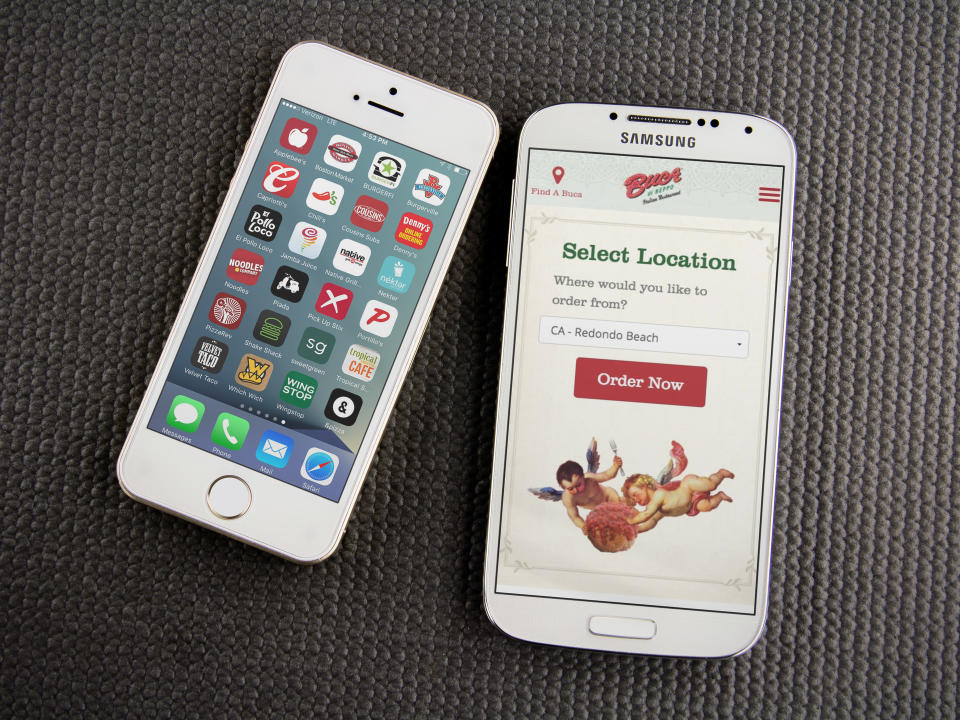Amazon just made a major move into the restaurant food delivery business
Amazon’s (AMZN) June announcement that it would purchase Whole Foods for $14 billion marked just the beginning of its efforts to dominate the food category. In July, reports uncovered the company’s roll-out of cook-at-home meal kits. And its latest announcement extends its focus on local food delivery, which solidifies its focus.
On Friday, the e-commerce giant announced a partnership with Olo, a delivery service company that powers 40,000 restaurant locations across the country. Olo—which counts Chipotle (CMG), Shake Shack (SHAK) and Dine Equity’s (DIN) Applebee’s as customers—says they see this partnership as a big opportunity for Amazon to gain scale with restaurants.
“There is a huge footrace going on in terms of companies launching delivery marketplaces,” Olo founder and CEO Noah Glass told Yahoo Finance. “A deal like this allows access to a broad swath of the restaurant market, including marquis brands.”

Olo, which has Shake Shack founder Danny Meyer as an investor, provides the technology platform to take orders directly to restaurants’ point-of-sale system, helping Amazon conquer the “last mile” efforts reaching customers locally.
Glass explained that the partnership not only simplifies the process for restaurants as orders come in but allows management of orders for restaurants, particularly during peak hours.
Growth in take-out
62% of restaurant-industry food transactions are consumed outside the restaurant, according to Glass, leaving a huge opportunity for names like Amazon that can take advantage on the delivery logistics side. In fact, the market for US restaurant delivery orders is expected to grow to $76 billion in 2022, from $43 billion today, according to Cowen & Co.
Companies have already been capitalizing on this growth. Food delivery name GrubHub (GRUB) is up almost 40% year-to-date (though off as much as 6% on Friday after the Olo-Amazon partnership announcement).
And more individual names are looking to invest in delivery. Even mass chains like McDonalds (MCD) which announced a partnership with UberEATS earlier this year.
Glass explained that Olo’s “Rails” app helps restaurants by going directly to point-of-sale instead of through multiple tablets that requires manually entering orders like with Seamless-Grubhub.
And Glass added the new partnership with Amazon for food delivery could extend to other categories in efforts to dominate the “last mile” reaching customers.
“I think food is just where this starts,” Glass said. “There are big players in the space with big ambitions beyond just food. We’re excited to be a part of this developing market.”
Amazon’s advantage
Amazon began a Prime Now one-hour restaurant delivery service in Seattle in 2015 and has since expanded it to other cities around the country. The service, which targets mostly mom-and-pop shops, hasn’t extended to large chains. The latest deal could do just that.
“We are excited to leverage Olo’s digital ordering technology and continue rapidly growing our network of restaurants to give Amazon Prime members more options for fast delivery from their favorite brands,” Gus Lopez, general manager of Amazon Restaurants, said in the press release. “This integration will enable Amazon Restaurants to onboard new restaurants with ease, as well as quickly add more new choices and delivery options for customers.”
Glass added that Amazon is focused on delivering high quality for customers.
“Amazon’s obsession with providing great customer and restaurant experience supports the evolving expectations and behaviors of today’s consumer,” Glass said.
And while economics of the arrangement aren’t clear, one thing’s for sure: the partnership increases Amazon’s interactions with consumers even more, as they continue to gain more data on preferences and spending.
Will Amazon dominate food take-out going forward?
“I think the food delivery market will most closely resemble the ride-sharing market,” Glass said. “I tend to use Uber in most of my travel, but in some markets I use Lyft because they dominate in som areas. So I think there will be one dominant player but there will be room for other names too.”
Nicole Sinclair is markets correspondent at Yahoo Finance
Please also see:
Fed balance sheet reduction won’t hurt the economy
Smartphone accessory maker: ‘You almost can’t believe these numbers’
FedEx CEO: I doubt ecommerce will ever dominate retail
Two reasons why the dollar keeps tumbling

